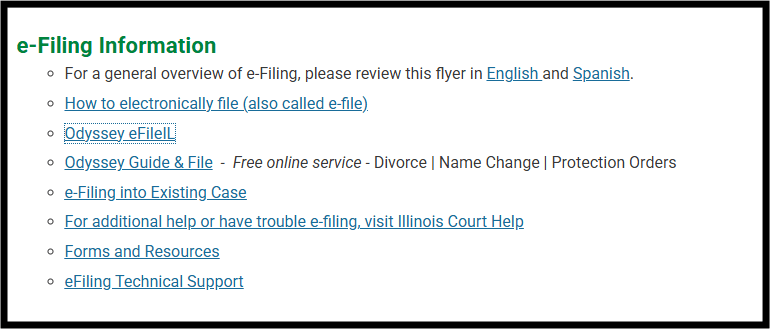In Illinois, even if you haven’t seen or spoken to your spouse in years, you can still get divorced. You just have to follow a few extra steps. We hope this blog serves as a helpful guide on “How to Divorce Someone You Haven’t Seen in Years”. In this blog, we intend to walk you through each step of that process.

While you may be able to do many of these steps yourself, people often choose to hire an attorney to do it for them because it can be time-consuming and stressful if you are unfamiliar with the process.
Step 1: Try to Find Your Spouse’s Address
In Illinois, the first step to divorcing someone you haven’t seen or spoken to in years is conducting a “diligent search.” Ideally, your attempts to locate your spouse would be successful.
However, keep records of who you contacted, the phone numbers or emails you contacted, and which websites or search engines you used to try to find them. This is important because if you cannot locate your spouse, the court requires proof that you made a diligent search to find them.

Ways you can find your spouse’s current address without an attorney
Ask your spouse for their current address
CAUTION: Do not attempt this if your estrangement is due to abuse or safety concerns. However, if you do not have any concerns about contacting them, then this can be a good practical first step.
Ask your spouse’s family or friends if they know their current address
If you are not comfortable reaching out directly, someone else close to them might be able to help.
Search for spouse’s employer
If you can see their social media accounts, take a look at those to see if you can find out their current place of employment. This will be helpful because you are allowed to serve them the divorce filing (aka Petition for Dissolution of Marriage) at their place of employment.
If you cannot find their social media accounts, try searching for their name on Google. This may lead you to profiles or updates that help you locate them.

How can a lawyer help find your spouse?
Access to paid databases
Attorneys often have access to professional databases and work with skip-tracing services that the general public cannot access without a paid subscription. These tools can often find updated addresses, phone numbers, employment, or other contact information based on their name, social security number, date of birth, and/or past addresses.
Knowledge of Illinois Law, Local Court Rules, and Judges’ Preferences
An experienced Illinois divorce lawyer knows the law, the local rules, and the preferences of the local family law judges. A good divorce attorney should know the type of diligent search to conduct and the best way to document the search to please the judge. This helps avoid unnecessary delays in your case.
Step 2: File for Divorce in Illinois
Once you have tried to locate your spouse, the next step is to file for divorce with your local circuit court.
To file for divorce, either you or your spouse must have lived in Illinois for at least 90 days. This is known as the residency requirement. As long as one party meets this 90-day residency requirement, you can file for divorce in Illinois, even if your spouse lives out of state or cannot be located.
Complete Required Forms
1. Petition for Dissolution of Marriage
2. Summons
3. Additional forms related to children or property, if applicable.
These forms can be found on the Illinois Supreme Court’s official website for Approved Statewide Forms — Divorce, Child Support, and Maintenance.
It is important to complete these forms accurately and thoroughly.
E-File the Documents
If you are seeking to file for divorce without an attorney in McLean County, Illinois, the McLean County Circuit Clerk website has several resources available to help you.
One important piece of information for you to know is that as of January 1, 2018, all civil cases in McLean County must be electronically filed (e-File). The McLean County Circuit Clerk website includes a section titled “e-Filing Information” with a link to e-File the Required Forms you have completed and a guide on how to e-File the Required Forms.

Pay filing fees
In order to file the documents you must create an account (Register) and pay the required filing fees. Filing fees vary by county and this blog focuses on McLean County.
Step 3: Serve Your Spouse
After filing the documents, you must serve your spouse with the Petition for Dissolution of Marriage, Summons, and any additional forms related to children or property that you filed.
If You Know Where to Serve Your Spouse
If you know your spouse’s current address or place of employment, then request a court date and give these documents to the sheriff’s office or a process server to attempt service.
Typically it is best to use a process server because they are invested in getting the person served and will strategically try different days and times to increase the likelihood of serving your spouse.
The sheriff’s office is less invested and usually only makes one or two attempts to serve the person. However, if you are concerned that your spouse will intentionally avoid service, the sheriff’s office can be more authoritative and effective.

If You Do NOT Know Where to Serve Your Spouse (Service by Publication)
If you cannot find your spouse’s current address or place of employment after completing your diligent search, then the next step is to attempt Service by Publication.
Motion with the Court
The first step to Service by Publication is to draft a Motion asking the judge to allow you to serve your spouse by publishing a notice of the Petition for Dissolution of Marriage in a local newspaper.
Affidavit of Diligent Search
The Motion for Service by Publication must include an Affidavit of Diligent Search, which explains the ways you tried to find your spouse. This is why in Step 1 we stress the importance of keeping records of your diligent search.
These records should include each attempt to contact either your spouse or their family or friends with the name, phone number, and email address you contacted and the date you contacted them. Also, keep records of the websites or search engines you used to try to find them and the date you conducted these searches.

Notice in a Newspaper
After the judge grants the Motion for Service by Publication, you must run the notice in the court-approved newspaper near your spouse’s last known location once a week for three consecutive weeks consistent with 750 ILCS 5/410 and 735 ILCS 5/2-207.
The Illinois Statute for Service by Publication mentions a different requirement for counties with greater than 2 million residents, but that only applies to residents of Cook County.
Proof of Newspaper Publication
After the notice runs, ask the newspaper to provide you with a Certificate of Publication. You must then provide this certificate to the court proving that the notice was published.

Step 4: Wait for Your Spouse to Respond
Your spouse has 30 days to respond after the date of service. For Service by Publication, the 30-day timeframe begins after the first publication date as described in 735 ILCS 5/2-207.
If your spouse responds in 30 days then the court will move forward with a contested divorce process, in which case you should consider hiring an experienced Divorce & Family Law attorney.
If your spouse does NOT respond in 30 days, you are then able to ask the court to move forward with the divorce without your spouse. Moving forward without your spouse is referred to as a Default Divorce.

To obtain a Default Divorce, you must file a motion for a default judgment and send notice to your spouse of the court hearing date on that motion. If your spouse does not appear at the court hearing, then the judge may enter a default judgment order. However, judges typically give respondents a few chances to appear because entering a divorce decree is very serious and can have heavy ramifications with respect to child custody, child support, property division, and maintenance.
It is important to understand that even if the judge grants a default divorce, that does NOT mean the judge grants all the relief requested in the Petition of Dissolution of Marriage. After obtaining default divorce order, you must schedule a court date for a prove-up hearing. The purpose of this hearing is to confirm the terms of the default judgment, ensuring the court’s formal approval of the divorce and the relief granted.
However, if you were never able to locate your spouse and service was by publication, then you can ask the court for a final divorce order without a prove up hearing. The reason for this is the court will likely issue a final divorce judgment order but will not include any other relief. Judges cannot require a defaulted spouse who was never served (other than by publication) to pay the other spouse money for maintenance, pay child support, or divide property. All of those matters will be reserved.
If you have children, the court can enter an order regarding custody but only on a temporary basis. Parenting time and decision-making responsibilities can be addressed on a more permanent basis once the unavailable spouse is located, served, or files an appearance in the case.
Learn More: Default Divorce in Bloomington

Step 5: Getting your Final Divorce Papers
Your divorce is not considered final until 30 days after the judgment, as this is the window of time your spouse has to file a motion to vacate a default divorce judgment or appeal the judge’s decision in a contested divorce hearing.
Assuming service was proper and you did not commit fraud to obtain the judgment, your divorce is final once those 30 days are over. Judges may allow an exception though if the respondent has a legitimate excuse for failing to appear (e.g. coma, military deployment, etc.). Judges try to strike a balance between allowing excuses that legitimately made it virtually impossible for the respondent to appear verses questionable excuses that seem like the person didn’t take the legal process seriously.
After the divorce is final, you will receive a document entitled “Final Judgment of Dissolution of Marriage”. Keep this in a safe place. You might need it to change your name or handle things like bank accounts, taxes, or later address an issue like maintenance, child custody, or child support.

Conclusion: How to Divorce Someone You Haven’t Seen in Years
Getting divorced from someone you haven’t seen in years is entirely possible in Illinois, as long as you follow the proper legal steps.
While you have the option to handle this process on your own, many people find that working with an experienced family law attorney can make things much smoother. Whether you choose to go through this process independently or with legal support, understanding your options and the legal requirements is the key to successfully finalizing your divorce.
Step 1: Try to find your spouse’s address. Document your diligent search in case you are unable to locate them.
Step 2: File for divorce.
Step 3: Serve your spouse. Use a process server or sheriff. If you are unable to locate them then serve by publication in the newspaper.
Step 4: Wait for your spouse to respond. If they respond then attend contested divorce hearings. If they don’t respond within 30 days, then attend the following prove-up hearings for a default divorce.
Step 5: Get your final divorce papers by attending the contested divorce or default divorce hearing (and subsequent prove-up hearing).
Reasons to Consider Hiring an Illinois Divorce Attorney
Saves Time
An experienced divorce attorney will ensure all forms are timely completed and filed with accuracy, and that all legal procedures are properly followed. Doing it right the first time saves you time.
Peace of Mind
Having an experienced professional manage your case can reduce stress and provide reassurance during a challenging time.
The divorce attorneys at Koth Gregory & Nieminski understand that your family, finances, and future are a top priority, which is why we offer SAME-DAY APPOINTMENTS. If you need a divorce or other family law services, you can schedule your first meeting through our online appointment calendar. We look forward to meeting you.
Related topics:
Can I Get a Divorce Without My Spouse Knowing?
Can You Get Divorced Without Your Spouse Signing the Papers?
What Happens If You Don’t Sign Divorce Papers?
Does It Matter Who Files for Divorce First in Illinois?
How Long Does Divorce Take in Illinois?
Disclaimer: This article (How to Divorce Someone You Haven’t Seen in Years) may contain information that is outdated as Illinois law continuously evolves. Meeting with an experienced divorce attorney is the best way to ensure you are receiving the most current information about How to Divorce Someone You Haven’t Seen in Years?

Published by Dustin Koth on April 21, 2025

